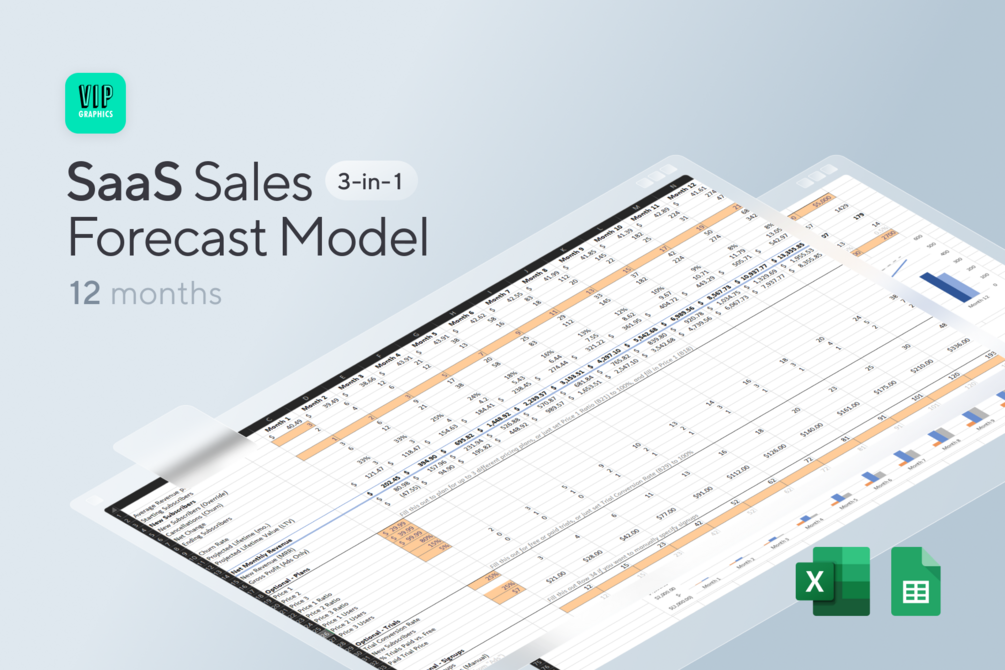
For any leader of a high-growth SaaS startup, the ability to predict the future is not a mystical power but a strategic discipline known as revenue forecasting. This critical process moves beyond mere guesswork, transforming your business vision into a quantifiable, actionable financial roadmap. A robust SaaS revenue forecasting template is the engine that powers this process, providing the structure and logic to project your future revenue with clarity and confidence. Without it, you are navigating the complex journey of scaling a business without a map, making decisions about hiring, marketing spend, and product development in the dark. An effective forecast illuminates the path ahead, allowing you to manage cash flow, extend your runway, and present a compelling, data-driven case to potential investors.
Moving Beyond the Simple Spreadsheet: The Anatomy of a SaaS Forecast
Many founders start with a simple spreadsheet that multiplies expected customers by an average price. However, this approach fails to capture the dynamic and nuanced nature of a subscription business. A true SaaS revenue forecasting template is built to model the key drivers of recurring revenue. At its core lies the concept of Monthly Recurring Revenue or MRR. The template must account for the different streams that contribute to MRR growth: New MRR from acquiring customers, Expansion MRR from existing customers upgrading their plans, and the inevitable erosion from Churn. This granular view is essential because it recognizes that not all revenue growth is equal. A business growing solely from new customers but hemorrhaging existing ones is on a far shakier foundation than one with strong net revenue retention.
The most critical function of a sophisticated template is its ability to model customer behavior over time. This involves defining your starting customer count and layering in assumptions for key metrics that will dictate your growth trajectory. You must input your monthly growth rate for new customer acquisition, a figure that may change as you scale. Simultaneously, the template requires your expected monthly churn rate. It is here that many forecasts stumble, as they often use a simplistic average churn percentage. A more advanced model differentiates between customer segments, acknowledging that churn for an annual enterprise client will be vastly different from that of a monthly-paying solo user. By incorporating these segmented assumptions, your SaaS revenue forecasting template becomes a more accurate and powerful planning tool, reflecting the complex reality of your business.
Integrating the Core Metrics That Drive Predictable Growth
A comprehensive forecast does not exist in a vacuum. It is intrinsically linked to the unit economics that determine the sustainability of your growth. Therefore, a well-designed SaaS revenue forecasting template integrates metrics like Customer Acquisition Cost and Lifetime Value. Projecting your marketing spend and calculating a future CAC allows you to see the efficiency of your growth. If your forecast shows revenue climbing but your CAC increasing even faster, it signals an unsustainable model that will burn through cash reserves. By modeling LTV alongside CAC, you can ensure that your growth strategy is not just effective but also profitable in the long term. This provides a crucial check on your ambitions, ensuring that every dollar spent on sales and marketing is an investment that pays back multiples over the customer’s lifetime.
Furthermore, a powerful template connects revenue to the broader financial picture. Revenue does not land in your bank account instantly; there is a crucial distinction between recognized revenue and cash flow, especially when dealing with annual contracts paid upfront. A advanced model will include a simple cash collection schedule to show you when the money from your sales actually becomes available to cover expenses. This prevents the dangerous trap of appearing profitable on paper while facing a cash crunch in reality. By linking the revenue forecast to your operating expenses and budget, the template allows you to project your future cash balance and calculate your runway under different scenarios. This holistic view is what transforms a simple revenue projection into a vital instrument for survival and strategic decision-making.
Transiding Your Forecast from a Static Document to a Dynamic Strategic Tool
The ultimate value of a SaaS revenue forecasting template is not in its initial creation but in its ongoing use as a living document. The market changes, new competitors emerge, and your own strategies evolve. A static forecast created at the beginning of the year quickly becomes obsolete. The discipline of a rolling forecast, updated quarterly or even monthly, is what separates high-performing startups from the rest. This process involves comparing your actual results to your forecasted numbers, analyzing the variances, and, most importantly, understanding the ‘why’ behind them. Did you miss your revenue target because of higher-than-expected churn or a slowdown in new sales? This analysis provides the insights needed to course-correct quickly.
This living document becomes your strategic compass. It empowers you to run ‘what-if’ scenarios to test the impact of different strategic choices. What if you increased your pricing by ten percent? What if you launched a new marketing campaign that reduced your CAC but required a significant upfront investment? A dynamic SaaS revenue forecasting template allows you to model these decisions before you commit precious resources, turning your financial plan into a sandbox for strategy. By providing this forward-looking visibility, a detailed forecast does more than just predict the future; it empowers you to shape it. It gives founders and their leadership teams the confidence to invest aggressively in areas of opportunity, the discipline to pull back when necessary, and the data-driven narrative needed to secure funding and drive sustainable, scalable expansion.





